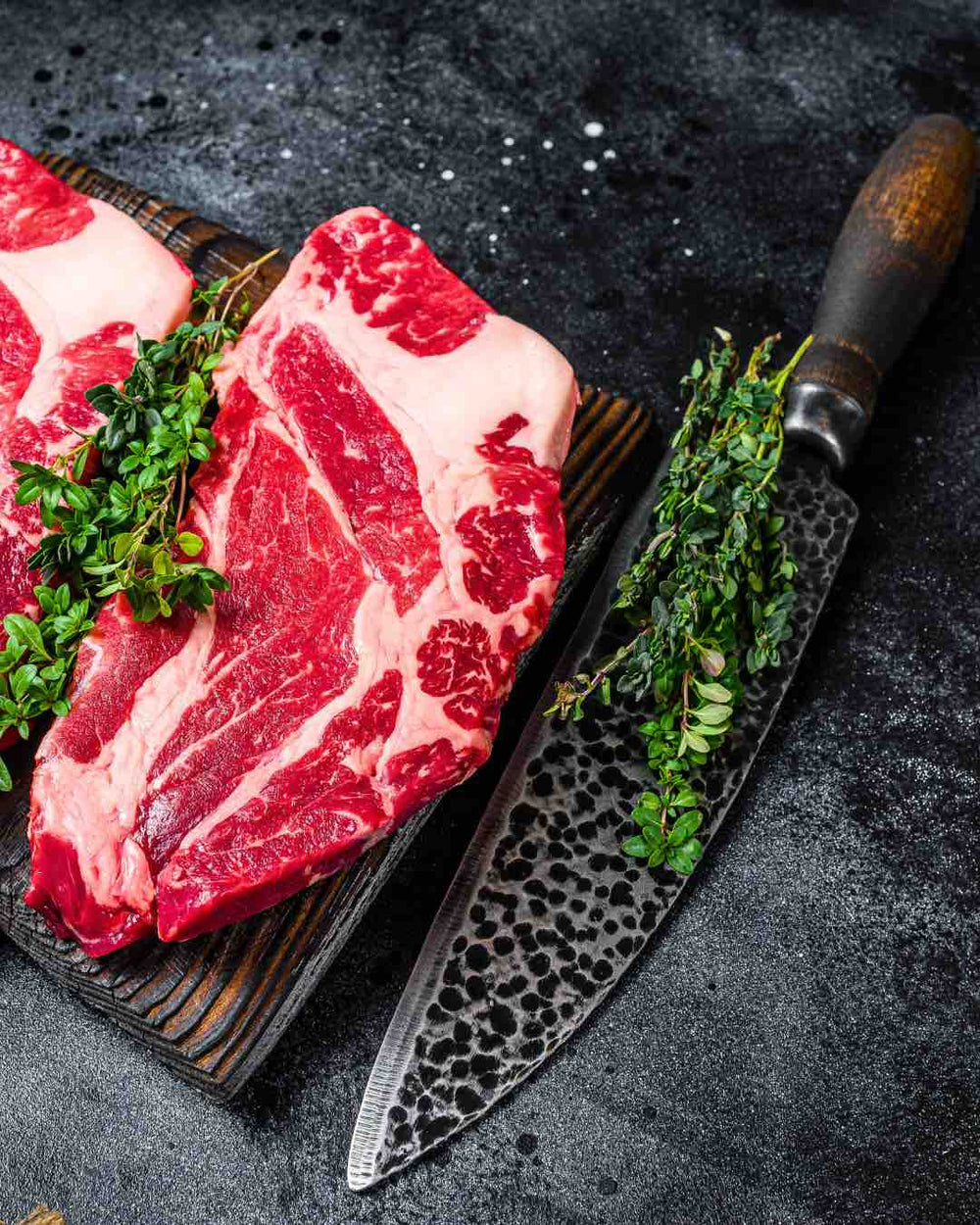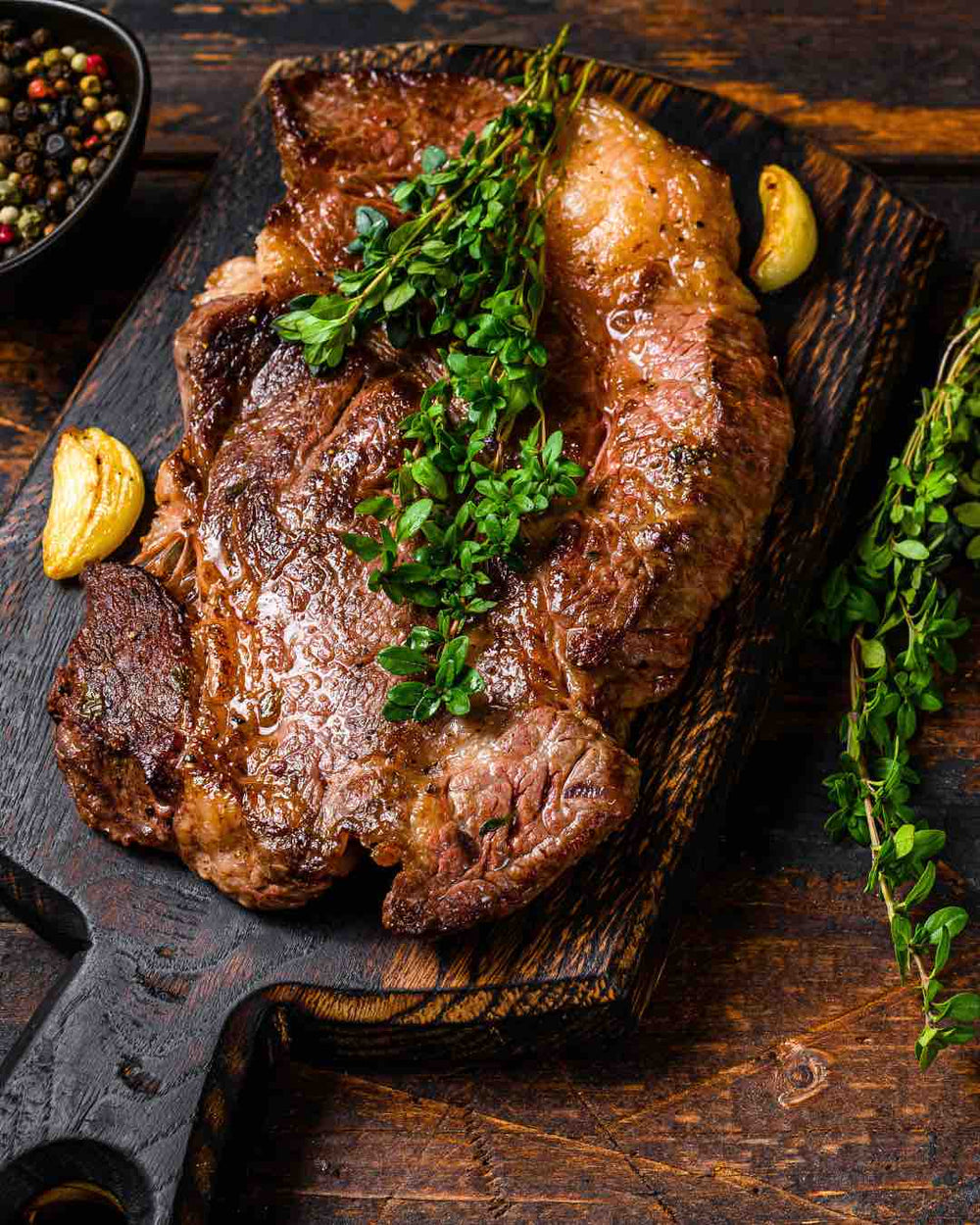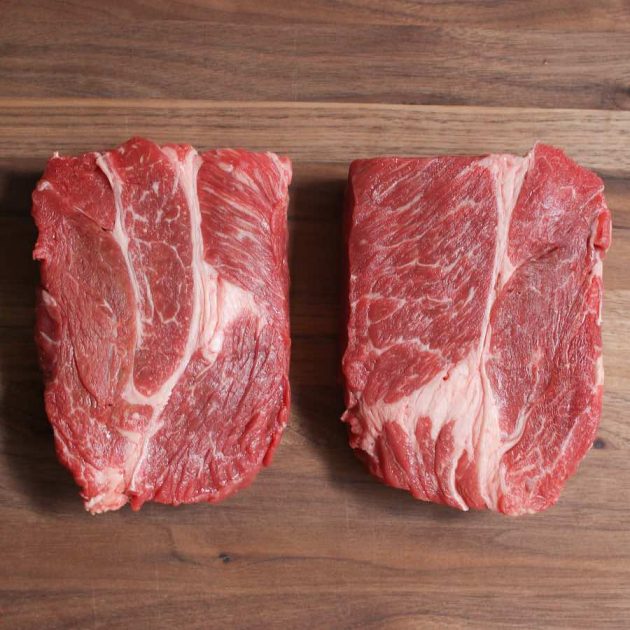
Introduction
Similarities And Differences Between Chuck Eye And Ribeye Steaks
Chuck eye steaks and ribeye steaks are both cuts of beef that come from similar parts of the cow. However, there are key differences that make them unique.
Chuck Eye Steaks:
- Chuck eye steaks come from the shoulder of the cow, specifically from the area around the chuck eye muscle.- They are less expensive than ribeye steaks.- Chuck eye steaks have a rich beef flavor and good marbling, but they are slightly less tender than ribeye steaks.- They are a versatile cut that can be prepared using various cooking methods such as grilling, broiling, or pan-searing.
Ribeye Steaks:
- Ribeye steaks come from the rib section of the cow, specifically from the area around the ribeye muscle.- They are considered one of the most flavorful and tender cuts of beef.- Ribeye steaks have excellent marbling, which enhances their tenderness and juiciness.- Due to their tenderness and flavor, they are often more expensive than chuck eye steaks.- Ribeye steaks are best grilled or pan-seared to enhance their natural flavors.
Importance Of Understanding Beef Cuts
Understanding the differences between beef cuts is important as it allows you to choose the right cut for your preferences and cooking method. Knowing the characteristics of each cut can help you make informed decisions when it comes to buying, preparing, and cooking beef.
When it comes to chuck eye vs ribeye steaks, the choice ultimately depends on personal preference, budget, and desired cooking method. If you prefer a tender and highly flavorful steak and are willing to spend a bit more, ribeye steaks are a great choice. However, if you are looking for a more affordable option with good flavor and versatility, chuck eye steaks are an excellent alternative.
In conclusion, both chuck eye and ribeye steaks offer unique qualities that can elevate your steak experience. By understanding the differences between these two cuts, you can make a well-informed decision based on your preferences and cooking needs.
Chuck Eye Steak Overview
Description Of Chuck Eye Steak
Chuck eye steak is a flavorful and affordable cut of beef that is sometimes referred to as the “poor man’s ribeye” due to its similarity in flavor and tenderness. It comes from the chuck primal located near the cow’s shoulder. Chuck eye steaks have a rich beef flavor and good marbling, making them a popular choice among beef enthusiasts.
Location And Characteristics Of Chuck Eye Muscle
The chuck eye muscle is located in the shoulder area of the cow. It is a muscle that is well-marbled with fat, which contributes to its flavor and tenderness. While not as tender as ribeye steaks, chuck eye steaks still offer a good balance of tenderness and flavor. They can be prepared using various cooking methods such as grilling, broiling, or pan-searing.
Chuck eye steaks are a versatile cut that can be used in a variety of dishes. They are often used as a substitute for ribeye steaks due to their similar flavor profile and more affordable price. Many people enjoy the rich, beefy taste of chuck eye steaks and find them to be a great option for everyday cooking or casual gatherings.
In summary, chuck eye steaks are a flavorful and affordable cut of beef that comes from the chuck primal in the cow’s shoulder. While they may not be as tender as ribeye steaks, they offer a good balance of tenderness and flavor. Chuck eye steaks are a versatile cut that can be prepared using various cooking methods. Whether you’re grilling, broiling, or pan-searing, chuck eye steaks are an excellent choice for those looking for a flavorful and budget-friendly steak option.
Ribeye Steak Overview
Description Of Ribeye Steak
Ribeye steak is a highly prized cut of beef known for its exceptional tenderness and rich flavor. It is often considered one of the best cuts of steak available. Ribeye steaks come from the rib section of the cow, specifically from the area around the ribeye muscle. The ribeye muscle is intensely marbled with fat, which contributes to its juiciness and flavor. This marbling gives the steak a buttery texture and results in a melt-in-your-mouth experience.
Location And Characteristics Of Ribeye Muscle
The ribeye muscle is located between the sixth and the twelfth ribs of the cow. It is a well-exercised muscle, which further enhances its flavor profile. The high amount of intramuscular fat, or marbling, in the ribeye muscle makes it incredibly tender and juicy when cooked properly. This marbling also provides a robust and beefy taste that is highly sought after by steak lovers.
Ribeye steaks can be prepared using various cooking methods, such as grilling, pan-searing, or broiling. Due to their higher fat content, ribeye steaks are less prone to drying out during the cooking process, making them forgiving and versatile. They are often enjoyed cooked to medium-rare or medium to fully appreciate their tenderness and flavor.
In summary, ribeye steaks are a top-tier cut of beef known for their tenderness, rich flavor, and abundant marbling. They come from the rib section of the cow, specifically from the ribeye muscle. The marbling in ribeye steaks contributes to their exceptional tenderness, juiciness, and flavor. Whether grilled, pan-seared, or broiled, ribeye steaks are a favorite choice among steak enthusiasts seeking the ultimate beef eating experience.

Flavor And Tenderness
Comparison Of Flavor Profiles In Chuck Eye And Ribeye Steaks
Ribeye steaks are well-known for their rich and intense beefy flavor. The marbling, or intramuscular fat, in these steaks contributes to their flavorful and juicy experience. The buttery texture of ribeye steaks enhances the overall taste and makes them a favorite choice among steak lovers. On the other hand, while chuck eye steaks are slightly less tender, they still deliver good flavor. However, they may require additional steps like marinades or slow cooking methods to achieve optimal tenderness.
Tenderness Factors And Marbling Differences
The tenderness of a steak is often related to the amount of marbling it contains. Ribeye steaks, with their high level of marbling, are naturally more tender compared to chuck eye steaks. The marbling in ribeye steaks not only adds flavor but also helps keep the meat moist during cooking, resulting in a tender and succulent steak. Chuck eye steaks, although less marbled, still offer good flavor but may require extra care to ensure tenderness.
In summary, ribeye steaks are renowned for their rich flavor and tenderness due to their abundant marbling. They provide a melt-in-your-mouth experience and are versatile in terms of cooking methods. Chuck eye steaks, while less tender, can still deliver good flavor and can be enhanced with appropriate cooking techniques. Ultimately, the choice between these two cuts depends on personal preference and the desired level of tenderness and flavor.
Cooking Techniques
Recommended Cooking Methods For Chuck Eye Steak
Chuck Eye steak is a tougher cut of beef compared to Ribeye steak, which means it benefits from slower cooking methods to help break down the connective tissues and tenderize the meat. Here are a few recommended cooking techniques for Chuck Eye steak:
- Braising: This method involves searing the steak on high heat and then slowly simmering it in a liquid, such as broth or wine, until it becomes tender and flavorful.
- Roasting: Chuck Eye steak can be roasted in the oven at a low temperature, allowing it to cook slowly and develop a tender texture. Adding some liquid to the roasting pan can help keep the meat moist during the cooking process.
- Sous Vide: This cooking technique involves vacuum-sealing the steak and cooking it in a water bath at a precise temperature for an extended period. It ensures even cooking and results in a tender and juicy steak.
Recommended Cooking Methods For Ribeye Steak
Ribeye steak is known for its rich flavor and tenderness, thanks to its marbling and fat content. Here are a few recommended cooking techniques for Ribeye steak:
- Grilling: Ribeye steak is perfect for grilling due to its high-fat content. The direct heat helps enhance the flavors and create a beautiful sear on the outside while keeping the inside moist and tender.
- Pan-searing: A cast-iron skillet or a heavy-bottomed pan works well for pan-searing Ribeye steak. This method allows you to achieve a nice crust on the outside while maintaining a juicy and tender interior.
- Broiling: Ribeye steak can be broiled in the oven on a high temperature setting. This method quickly cooks the steak, creating a delicious crust and locking in the juices for a flavorful result.
Remember to let the steak rest for a few minutes after cooking to allow the juices to redistribute for maximum tenderness. Whether you choose to cook Chuck Eye steak or Ribeye steak, these recommended cooking methods will help you achieve the best results for each cut.
Nutritional Aspects
Nutritional Value Comparison Of Chuck Eye And Ribeye Steaks
When comparing the nutritional value of Chuck Eye steak and Ribeye steak, it’s important to note that both cuts offer essential nutrients that contribute to a healthy diet. However, there are some differences to consider:
| Nutrient | Chuck Eye Steak | Ribeye Steak |
|---|---|---|
| Protein (g) | 26 | 23 |
| Fat (g) | 15 | 28 |
| Calories | 275 | 302 |
| Iron (mg) | 1.9 | 2.2 |
| Vitamin B12 (mcg) | 2.6 | 2.1 |
| Zinc (mg) | 4.5 | 5.7 |
| Vitamin A (IU) | 6 | 11 |
| Vitamin E (mg) | 1.1 | 0.5 |
It’s evident that Ribeye steak contains a higher amount of fat compared to Chuck Eye steak. The marbling in Ribeye steak contributes to its tenderness and flavor but also adds to the higher fat content. If you’re watching your fat intake, Chuck Eye steak may be a better option.
Health Benefits And Considerations
Both Chuck Eye steak and Ribeye steak offer health benefits due to their nutrient profiles:
- Protein: Both cuts provide a good amount of protein, which is essential for muscle building and repair.
- Iron: Both cuts are a good source of iron, which is important for oxygen transport and energy production in the body.
- Vitamin B12: Both cuts contain vitamin B12, which is necessary for a healthy nervous system and the production of red blood cells.
- Zinc: Both cuts provide zinc, which is crucial for immune function, wound healing, and cell growth.
However, it’s worth noting that Ribeye steak contains more calories and fat compared to Chuck Eye steak. If you’re watching your calorie intake or trying to maintain a healthy weight, you may prefer the leaner Chuck Eye steak.
Overall, both Chuck Eye steak and Ribeye steak can be enjoyed as part of a balanced diet. Consider your dietary needs and goals when choosing between the two cuts, and remember to practice portion control to maintain a healthy and balanced eating pattern.

Texture And Juiciness
Texture Differences In Chuck Eye And Ribeye Steaks
Chuck Eye steak and Ribeye steak have different textures due to their muscle structure and fat content. Here’s a comparison of their texture characteristics:
- Chuck Eye steak: This cut comes from the shoulder of the cow, which is a working muscle. As a result, Chuck Eye steak tends to have a firmer texture compared to Ribeye steak.
- Ribeye steak: This cut comes from the rib section of the cow, which is less worked and contains more marbling. The marbling in Ribeye steak contributes to its tenderness and creates a more melt-in-your-mouth texture.
How Juiciness Affects Eating Experience
Juiciness is an important factor in the enjoyment of a steak. It refers to the amount of moisture retained in the meat during cooking. Here’s how juiciness differs between Chuck Eye and Ribeye steaks:
- Chuck Eye steak: The moderate marbling in Chuck Eye steak helps to maintain moisture during cooking, resulting in a juicy eating experience. While not as tender as Ribeye steak, Chuck Eye steak offers a satisfying bite.
- Ribeye steak: The higher amount of marbling in Ribeye steak contributes to its juiciness. The marbling acts as a natural basting agent, keeping the meat moist and enhancing its flavor. Ribeye steak is known for its succulence and well-rounded taste.
Ultimately, the choice between Chuck Eye steak and Ribeye steak comes down to personal preference. If you prefer a firmer texture with moderate marbling, Chuck Eye steak may be for you. On the other hand, if you desire a melt-in-your-mouth texture with pronounced succulence, Ribeye steak is the way to go. Consider your texture and juiciness preferences when making your decision.
Price And Availability
Price Comparison Between Chuck Eye And Ribeye Steaks
When it comes to price, chuck eye steak is generally more affordable compared to ribeye. Chuck eye steak is considered a less expensive option, making it a budget-friendly choice for those looking for a delicious steak without breaking the bank. Ribeye, on the other hand, is often priced higher due to its popularity and superior tenderness.
Availability In Supermarkets And Butcher Shops
Chuck eye steak and ribeye can be found in most supermarkets and butcher shops. However, due to its lower cost, chuck eye steak tends to be more widely available and can be easily found in most grocery stores. Ribeye, on the other hand, may be less commonly available and may require a visit to a specialty butcher shop or a higher-end supermarket.
It’s important to note that availability can vary depending on your location and the specific stores in your area. It’s always a good idea to check with your local supermarket or butcher shop to inquire about the availability of both chuck eye steak and ribeye.
In conclusion, when it comes to price, chuck eye steak is generally more affordable than ribeye. Chuck eye steak is widely available in most supermarkets, while ribeye may require visiting a specialty shop. Consider your budget and availability when making a decision between these two flavorful cuts of beef.
Conclusion
Summary Of Key Differences Between Chuck Eye And Ribeye Steaks
Choosing The Right Steak For Your Preferences And Budget
In summary, when comparing Chuck Eye and Ribeye steaks, there are a few key differences to consider.
- Price: Chuck Eye steak is generally more affordable than Ribeye, making it a budget-friendly option for steak lovers.
- Availability: Chuck Eye steak is widely available in most supermarkets, while Ribeye may require a visit to a specialty butcher shop or higher-end supermarket.
- Flavor: Ribeye is known for its tenderness and marbling, which gives it a rich and buttery flavor. Chuck Eye steak, while slightly less tender, still offers great flavor when cooked properly.
- Cooking method: Both cuts can be cooked in a variety of ways, such as grilling, pan-searing, or broiling. Choose the method that suits your preferences and cooking equipment.
- Personal enjoyment: Ultimately, the choice between Chuck Eye and Ribeye comes down to personal enjoyment. Some people prefer the buttery tenderness of Ribeye, while others enjoy the more affordable and flavorful experience of Chuck Eye steak.
When choosing the right steak for your preferences and budget, consider the factors mentioned above. If you’re looking for an affordable option that still delivers great flavor, Chuck Eye steak is a great choice. If you’re willing to splurge for a premium cut with exceptional tenderness, Ribeye is the way to go.
Both Chuck Eye and Ribeye steaks offer a delicious and enjoyable steak experience. So, whether you’re grilling for a barbecue, preparing a special dinner, or simply enjoying a steak at home, you can’t go wrong with either choice. Enjoy your steak and savor the flavors that each cut has to offer!
FAQ: Chuck Eye vs Ribeye: Deciphering Beef Cuts
Looking to understand the difference between chuck eye and ribeye cuts of beef? You’ve come to the right place! This FAQ will help you decode these two popular cuts and decide which one suits your preferences and culinary needs.
Q: What is chuck eye?
A: Chuck eye is a beef cut that comes from the shoulder area of the cow. It is cut from the same region as the chuck roast, but is distinguished by the presence of the eye muscle, which is tender and packed with flavor. Chuck eye is also known as the “poor man’s ribeye” due to its similarities in taste and texture to ribeye steak, albeit at a more affordable price point.
Q: What is ribeye?
A: Ribeye is a well-known and highly revered cut of beef that is taken from the rib area of the cow. It is known for its rich marbling and exceptional tenderness, making it a favorite among steak lovers. Ribeye often features a generous cover of fat, which adds flavor and juiciness to the steak when cooked.
Q: What are the differences in flavor and texture between chuck eye and ribeye?
A: While both cuts offer exceptional taste and tenderness, there are some noticeable differences. Ribeye is renowned for its unmatched buttery texture and intense beefy flavor. Its abundant marbling makes it incredibly juicy and succulent. On the other hand, chuck eye is slightly less tender than ribeye, but still boasts a good amount of flavor. The chuck eye’s moderate marbling contributes to its rich taste and ample juiciness.
Q: Which cut is more affordable?
A: If you’re looking to save a few dollars without compromising on flavor, chuck eye is the way to go. As mentioned earlier, it is often referred to as the “poor man’s ribeye” because of its similarity in taste and texture to ribeye, but at a more budget-friendly price. Ribeye, being a premium cut with higher marbling, generally commands a higher price point.
Q: How should these cuts be cooked?
A: Both chuck eye and ribeye can be cooked using similar methods. For the perfect steakhouse experience, the preferred cooking method is usually grilling or pan-searing. These methods help to bring out the natural flavors and tenderness of the meat. Remember to season the steaks with salt and pepper, and cook them to your desired level of doneness.
Q: Can these cuts be used interchangeably in recipes?
A: While chuck eye and ribeye have similar characteristics, they do have subtle differences. Due to its tenderness and rich marbling, ribeye is often considered the top-choice for those seeking a luxurious steak experience. Chuck eye, although flavorful, may require slightly different cooking techniques to achieve optimum tenderness. Thus, while they can be used interchangeably in recipes, it’s important to consider the individual attributes of each cut.
In summary, both chuck eye and ribeye offer incredible flavor and tenderness. Chuck eye provides an affordable alternative to the ribeye, while still delivering a great taste. Whether you opt for the buttery tenderness of ribeye or the budget-friendly chuck eye, both cuts are sure to satisfy your carnivorous cravings.

American Restaurant, BBQ, Smokehouse, Texas Style Barbecue serving Prime Imported Beef raised on strict diet with no hormones and no antibiotics. Smoked low and slow old school over pure imported wood fire with no gas and no electricity.